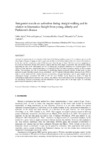Mostrar o rexistro simple do ítem
Antagonist muscle co-activation during straight walking and its relation to kinematics: Insight from young, elderly and Parkinson's disease
| dc.contributor.author | Arias, Pablo | |
| dc.contributor.author | Espinosa, Nelson | |
| dc.contributor.author | Robles-García, Verónica | |
| dc.contributor.author | Cao, Ricardo | |
| dc.contributor.author | Cudeiro, Javier | |
| dc.date.accessioned | 2015-04-27T10:31:00Z | |
| dc.date.available | 2015-04-27T10:31:00Z | |
| dc.date.issued | 2012-03-21 | |
| dc.identifier.citation | Arias P, Espinosa N, Robles-García V, Cao R, Cudeiro J. Antagonist muscle co-activation during straight walking and its relation to kinematics: Insight from young, elderly and Parkinson's disease. Brain Research. 2012;1455:124-131. | es_ES |
| dc.identifier.uri | http://hdl.handle.net/2183/14451 | |
| dc.description.abstract | [Abstract] Increased antagonist muscle co-activation of the lower limb during walking seems to be an adaptive process to the physiological changes of aging, in order to gain joint stability. In the healthy subjects this view seems to be reinforced by the fact that the co-activation index (CAI) increases when the gait is faster. The few reports on antagonist co-activation in Parkinson's disease (PD) patients indicate that they have larger co-activation than the healthy elderly, supporting the idea of the stabilization role of CAI during gait, as postural instability is a cardinal feature of PD. However it has also been reported that there is a reduction of the CAI when increasing velocity in PD or normal elderly. This questions the role of coactivation in stabilization during increased velocity. In this study we have analyzed the gait of healthy subjects (young and elderly), and PD patients (with and without freezing of gait, FOG) in order to better understand the relation between co-activation and gait kinematics, and to gain insight into the pathological changes associated with FOG in PD. We used Multiple Linear Regression models to study the relationship in shank muscles between CAI, velocity and cadence. Our results indicate that, for all groups of interest, the relationship between co-activation and the kinematics of gait is poor, due to the high degree of variability, questioning the explanatory value of the index. | es_ES |
| dc.description.sponsorship | This work was supported by Xunta de Galicia (Conselleria de Educación-2007/000140-0 and Dirección Xeral de I+D+i; 2010–2012), Spain. We are thankful to the Asociación Parkinson Galicia. We are indebted to Dr Kenneth L. Grieve for his helpful advice and corrections in the manuscript. | |
| dc.description.sponsorship | Xunta de Galicia; 2007/000140-0 | |
| dc.language.iso | eng | es_ES |
| dc.publisher | Elsevier | es_ES |
| dc.relation.uri | httP://dx.doi.org/10.1016/j.brainres.2012.03.033 | es_ES |
| dc.rights | This is the author’s version of a work that was accepted for publication in "Brain research". Changes resulting from the publishing process, such as peer review, editing, corrections, structural formatting, and other quality control mechanisms may not be reflected in this document. Changes may have been made to this work since it was submitted for publication. | es_ES |
| dc.subject | Kinematics | es_ES |
| dc.subject | Parkinson | es_ES |
| dc.subject | CAI | es_ES |
| dc.subject | Multiple linear regression | es_ES |
| dc.subject | Gait | es_ES |
| dc.title | Antagonist muscle co-activation during straight walking and its relation to kinematics: Insight from young, elderly and Parkinson's disease | es_ES |
| dc.type | info:eu-repo/semantics/article | es_ES |
| dc.rights.access | info:eu-repo/semantics/openAccess | es_ES |
Ficheiros no ítem
Este ítem aparece na(s) seguinte(s) colección(s)
-
GI-NEURO - Artigos [158]
-
INIBIC-NEURO - Artigos [48]






